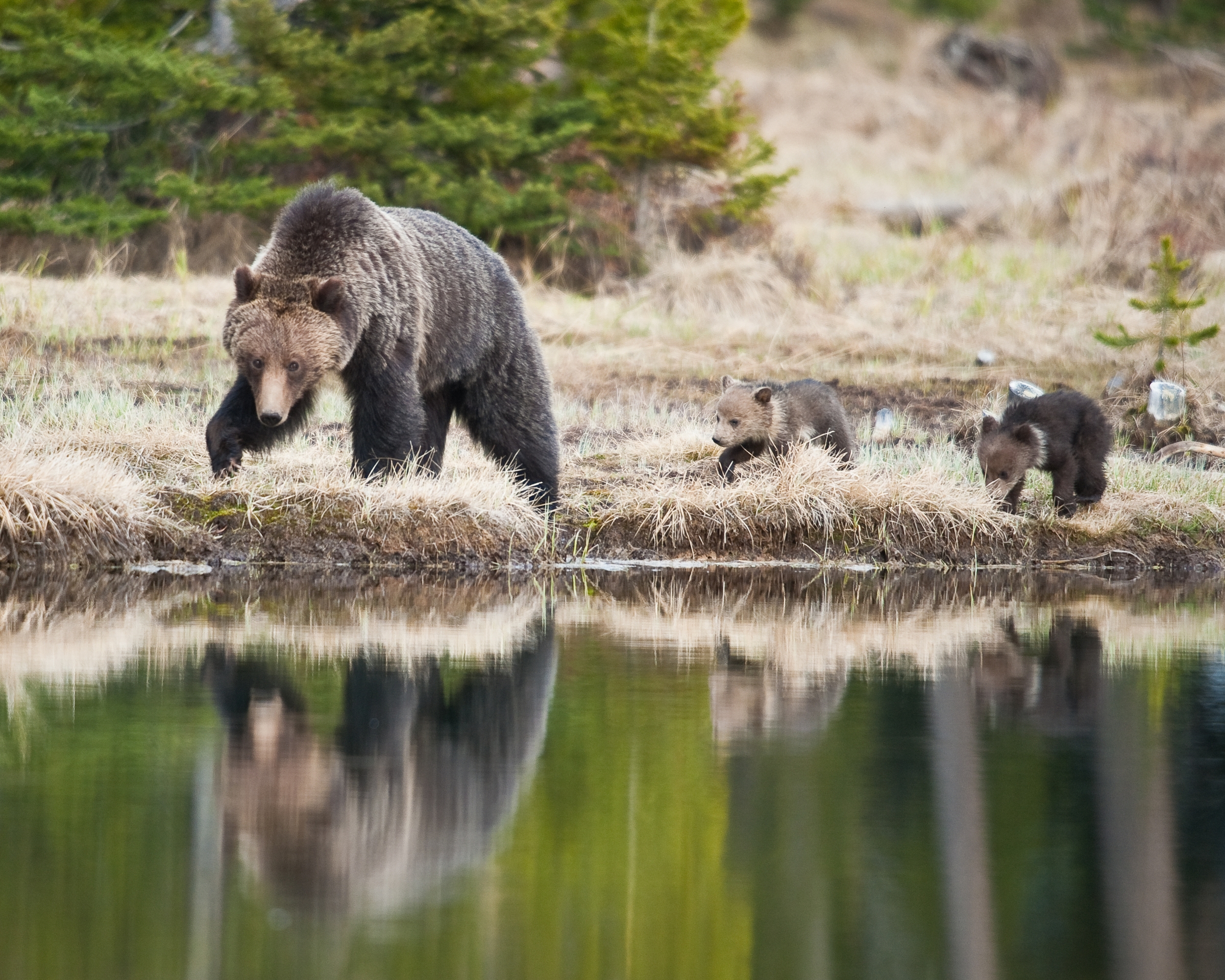
Grizzly bear sow and young cubs. Yellowstone National Park, Wyoming. Photo by Sam Parks.
President Biden’s commitment to conserve 30% of U.S. land and ocean by 2030 offers hope that major changes could soon be on the horizon for federal agencies in charge of managing public lands. That is good news for imperiled species in the northern Rockies. The region contains some of the last vestiges of intact wildlife habitat that desperately needs immediate protection as the Forest Service continues to implement the destructive priorities of the last administration—more logging, road building, grazing, and industrial-scale recreation.
The Trump administration’s vastly inflated timber production targets still drive U.S. Forest Service projects, which include adding and opening more logging roads in areas crucial for grizzly bear recovery. The targets also include logging in Roadless Areas and places where trees are hundreds of years old. In fact, the agency plans to cut whole swaths of forests to create “openings” that look pretty much like clearcuts from decades long past.
Opening abandoned roads in Roadless Areas undermines the very purposes of their protection, which includes providing strongholds for threatened and endangered species. Roadless Areas near and along the Idaho/Montana border provide essential stepping stones for wandering grizzlies leaving the official recovery zones within the Cabinet-Yaak and North Continental Divide Ecosystems. Without safe passage, grizzly bears cannot find new territory or new mates, furthering genetic isolation. Instead of improving Roadless Areas and increasing habitat security for grizzlies, the Forest Service continues to push damaging projects that impede connectivity and recovery.
For example, as part of its Sawmill-Petty project the Lolo National Forest proposed adding 142 miles of roads to its official transportation system, in addition to logging 434 acres in the Garden Point Roadless Area, which includes a 69-acre clearcut it euphemistically labeled a “regeneration harvest.” Even worse, the Redd Bull project would log 1,425 acres, which includes more than a square mile of clearcuts in the Marble Point Roadless Area, while also “opening” 735 acres of old-growth forest throughout the project area. To access all the cutting units, the Forest Service would reopen overgrown roads not utilized since the 1990’s, even though rules for Roadless Areas prohibit their reconstruction.
The two projects appear to represent a trend as the Forest Service pursues meeting its industrial logging targets not only inside Roadless Areas, but also within the designated grizzly bear recovery zones and areas crucial for connectivity. These wild places have specific protections such as limits on road density, yet, the agency continues to propose building new roads and opening those roads long-abandoned or closed.
The Lolo National Forest, for example, recently approved its Soldier-Butler project that contains one of just two official grizzly bear connectivity areas in Montana. Here the agency approved opening abandoned roads in order to log across 5,510 acres—including a 114 acre clearcut. Further north, the Kootenai National Forest proposes to clearcut over 2,000 acres as part of the Black Ram Project, which is just one of five massive logging projects proposed or in progress that span 300,000 acres along Montana’s borders with Idaho and Canada. These projects include road construction and adding old roads back onto the transportation system, which greatly threatens the few grizzly bears remaining within the Cabinet-Yaak Ecosystem.
Meanwhile, the Flathead National Forest’s Mid-Swan Landscape Restoration Project includes a staggering 6,816 acres of clearcuts spread across the sprawling 174,000 project area. Along with the nearby Frozen Moose and Bug Creek Projects, the Forest Service would commercially log 45,991 acres all within the grizzly bear’s primary conservation area of the Northern Continental Divide Ecosystem.
The Forest Service asserts all of this chainsawing and bulldozing is necessary to “reduce catastrophic wildfire risk” and “increase resilience to insects and disease,” while claiming the clearcuts simply “mimic natural disturbance patterns.” Yet, 100 years of Forest Service active management has, in fact, halted forests from acting like forests, which need big wildfires, insects, disease, and other ecological processes to naturally regenerate and provide quality wildlife habitat. The fact that we are now seeing the Forest Service use past mismanagement as an excuse to log more forests today is a testament to the agency’s hubris in asserting it can replicate mother nature. It is also a rejection of science that shows long-term drought and increased temperatures due to the climate crisis influence wildfires more than any other factor.
Contrary to assertions by the Forest Service and the timber industry, no amount of logging, especially far from people’s homes, is going to keep communities safe from fast-moving, high-intensity wildfires. Pretending otherwise will continue to imperil people’s homes, as well as, fish and wildlife in Montana and throughout the northern Rockies. President Biden has an opportunity to not only protect crucial grizzly bear habitat, Roadless Areas, and old-growth forests, but also to rein in an agency that believes restoration requires a chainsaw.